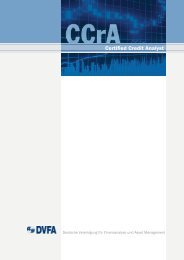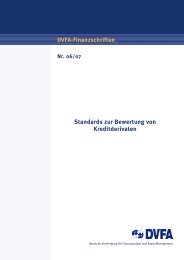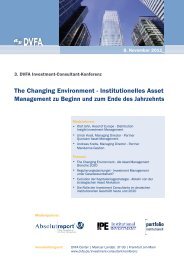KPIs for ESG - DVFA
KPIs for ESG - DVFA
KPIs for ESG - DVFA
You also want an ePaper? Increase the reach of your titles
YUMPU automatically turns print PDFs into web optimized ePapers that Google loves.
The company must ensure complete, transparent, continual and up-to-date <strong>ESG</strong> reporting that contains the most<br />
important <strong>ESG</strong>-<strong>KPIs</strong>.<br />
The in<strong>for</strong>mation, data, processes and assigned competencies required <strong>for</strong> the preparation of <strong>ESG</strong> reports should be<br />
recorded, analysed, documented and disclosed in such a way that they would stand up to an internal and external<br />
audit or review. An independent audit by well-qualified third parties is a particularly good way to increase the<br />
assurance capability (i.e. perceived reliability) of the reported <strong>ESG</strong>-<strong>KPIs</strong>. This also serves to ensure the credibility and<br />
acceptance of <strong>ESG</strong> communication among the target groups. As a rule, external auditing carries the additional<br />
advantage that <strong>ESG</strong> reporting and <strong>ESG</strong> management can be improved based on the best practices referred to by the<br />
auditor.<br />
For any recommendation other than these, corporates should generally align <strong>ESG</strong> reporting with all other reporting to<br />
the capital markets.<br />
The IASCF’s technical summary entitled “Framework <strong>for</strong> the Preparation and Presentation of Financial Statements” 4<br />
may serve as a guideline <strong>for</strong> underlying principles of user-oriented reporting. Although the IASCF document makes<br />
suggestions about financial statements only, the recommendations can also be applied to <strong>ESG</strong> data:<br />
“Qualitative characteristics are the attributes that make the in<strong>for</strong>mation provided in financial statements useful to<br />
users. The four principal qualitative characteristics are understandability, relevance, reliability and comparability.” 5<br />
2. Disclosure and reporting on <strong>ESG</strong> line items<br />
Section 2.2 (Plausibility) of the <strong>DVFA</strong> Principles <strong>for</strong> Effective Financial Communication explains that<br />
“Company reports should be consistent and plausible. Financial in<strong>for</strong>mation should be quantified and<br />
sufficiently documented.” 6<br />
Quantification and documentation are also the most essential criteria relating to <strong>ESG</strong> data <strong>for</strong> investment<br />
professionals!<br />
Be<strong>for</strong>e looking at the concept of key per<strong>for</strong>mance indicators (<strong>KPIs</strong>), however, it is important to understand the <strong>for</strong>mat<br />
in which the quantifiable data should be delivered.<br />
First of all, the following recommendation on plausibility quoted from the <strong>DVFA</strong> principles can be easily adapted to<br />
<strong>ESG</strong> data:<br />
2.2.2 The method used <strong>for</strong> the calculation of reported figures is disclosed.<br />
2.2.3 Segment reporting adequately represents the company, its lines of business and geographical<br />
distribution.<br />
2.2.4 The structure of reports as well as the content and scope of data included is only changed in justified<br />
cases.<br />
Section 3.1. (Continuity and Recentness) continues by recommending the following principles:<br />
3.1.1 Time series are consistent over time.<br />
3.1.2 Changes to already defined segments are only made in justified exceptional cases.<br />
4<br />
http://www.iasb.org/NR/rdonlyres/<br />
E366C162-17E4-4FBE-80EB-7A506A615138/0/Framework.pdf<br />
26 February 2008<br />
5<br />
ibid, page 1<br />
6<br />
ibid, page 12<br />
© <strong>DVFA</strong> April 2010 ALL RIGHTS RESERVED. No part of this publication may be reproduced, stored in a retrieval system, or transmitted, in any <strong>for</strong>m or by any<br />
means, electronic, mechanical, recording, without the prior permission of the copyright holder.<br />
8

















